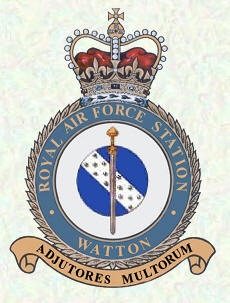RAF Watton
| RAF Watton USAAF Station AAF-376 |
|||||||
|---|---|---|---|---|---|---|---|
 |
|||||||
| Watton, Norfolk, England | |||||||
 |
|||||||
| Coordinates | 52°33′50″N 0°51′47″E / 52.564°N 0.863°E | ||||||
| Type | Royal Air Force station | ||||||
| Site information | |||||||
| Owner | Ministry of Defence | ||||||
| Controlled by |
|
||||||
| Site history | |||||||
| Built | 1937 | ||||||
| Built by | John Laing & Son Ltd. | ||||||
| In use | 1937-1978 or 1992. | ||||||
| Battles/wars | Second World War | ||||||
| Garrison information | |||||||
| Garrison |
RAF Bomber Command Eighth Air Force |
||||||
| Occupants | 25th Bombardment Group (Reconnaissance) | ||||||
| Airfield information | |||||||
| Elevation | 57 metres (187 ft) AMSL | ||||||
|
|||||||
Royal Air Force Station Watton or more simply RAF Watton is a former Royal Air Force station located 9 mi (14 km) southwest of East Dereham, Norfolk, England.
Opened in 1937 it was used by both the Royal Air Force (RAF) and United States Army Air Forces (USAAF) during the Second World War. During the war it was used primarily as a bomber airfield, being the home of RAF Bomber Command squadrons until being used by the United States Army Air Forces Eighth Air Force as a major overhaul depot for Consolidated B-24 Liberator bombers and as a weather reconnaissance base.
After the war, it was returned to RAF use until being turned over to the British Army in the early 1990s. It was closed then put up for sale.
RAF Watton was a permanent RAF station built by John Laing & Son in 1937, and first used as a light bomber airfield housing for varying periods by RAF Bomber Command.
The following squadrons and units were based at Watton at some point during this time:
In 1943 Watton was turned over to the United States Army Air Forces Eighth Air Force for use as an air depot. The airfield was originally grass surfaced but, during the American tenure, the airfield had a 2,000 yd (1,829 m) long concrete runway constructed. A concrete perimeter track was built and a total of fifty-three hardstandings, of which forty-one were spectacle and twelve of the frying-pan type. The four original C-type hangars, arranged in the usual crescent on the northern side of the airfield, were backed by the permanent buildings of the pre-war RAF camp. Additional hangars were added and three blister hangars at dispersals. The construction of the airfield necessitated the closure of two public roads.
...
Wikipedia

